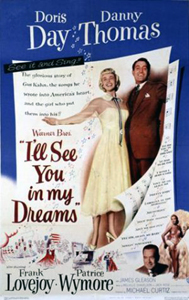| I'll See You in My Dreams | |
|---|---|
 Theatrical release poster | |
| Directed by | Michael Curtiz |
| Written by | Jack Rose Melville Shavelson |
| Story by | Louis F. Edelman Grace Kahn |
| Produced by | Louis F. Edelman |
| Starring | Doris Day Danny Thomas Frank Lovejoy Patrice Wymore James Gleason |
| Cinematography | Ted D. McCord |
| Edited by | Owen Marks |
| Music by | Ray Heindorf |
| Distributed by | Warner Bros. |
Release date |
|
Running time | 110 minutes |
| Country | United States |
| Language | English |
| Budget | $1,404,000 [1] |
| Box office | $2.9 million (US rentals) [2] . |
I'll See You in My Dreams is a 1951 musical film directed by Michael Curtiz and starring Doris Day and Danny Thomas. It was Warner Brothers' second-highest-grossing film of 1951. Curtiz teamed with Thomas again the following year for a remake of The Jazz Singer . [3]
Contents
The film is a biography of lyricist Gus Kahn and includes a number of songs written by him, including the title song. The story, which avoids Kahn's Jewish origins, is told from the point of view of his wife Grace, who was alive when the film was produced. Kahn had died in 1941. He was a prolific songwriter who met Grace LeBoy in 1908. His career ascended to spectacular heights with hits like "Pretty Baby", "My Buddy", "Toot, Toot, Tootsie" and "Makin' Whoopee". But he lost his savings in the 1929 stock-market crash. [4]